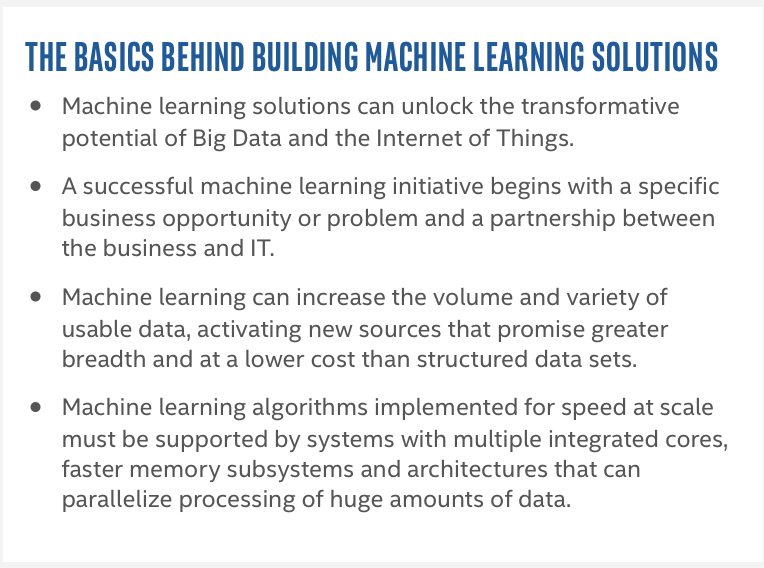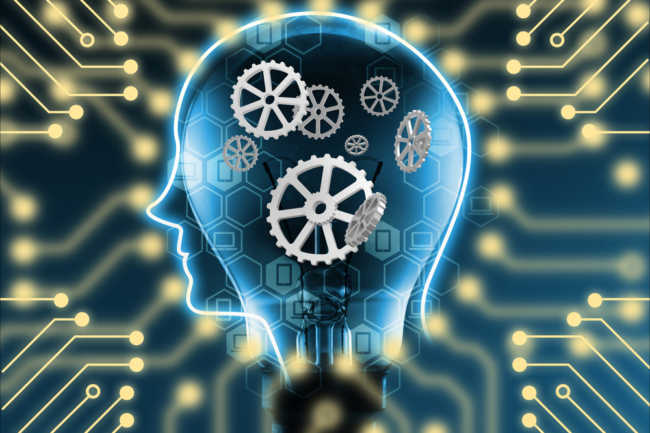The Basics Behind Building Machine Learning Solutions
Machine Learning Requires a Systematic Approach to Systems, Architecture, and data. Developing Machine Learning analytics yields immediate and long-term benefits.
1. Make Machine Learning Part of a Modernization Strategy
After decades in research labs, machine learning is now getting enormous attention for real-world applications that harness the technology’s formidable power to discern patterns in huge quantities and types of data at high speed: fraud detection, customer 360, facial recognition, workflow management, shopping personalization and much more.
The payback of such initiatives can be big. But even greater opportunities lie in creating advanced analytic systems that use machine learning’s unmatched ability to see, organize and leverage insights from ever-growing mounds of data to unlock the deep, transformative potential of Big Data and the Internet of Things.

To get to the next level of machine learning, companies must develop a sound business case; implement machine learning algorithms for speed at scale; use systems equipped with processors with multiple integrated cores, faster memory subsystems, and develop architectures that can handle massive amounts data in real time.
For many organizations, it is an ideal time to build on or begin machine-learning experience, deepen knowledge, and reap the benefits and competitive advantages this sophisticated data analytics technology can provide.
The important first step is recognizing that machine learning and advanced analytics are a fundamental part of the digital revolution.
2. Start with the Business Case (and Start Small)
As companies move forward with advanced analytics, IT should involve business decision makers in the initial R&D phase. It’s likely the business side is already considering ways to get new insights. Many will implement the analytic applications and other AI solutions they need with or without IT. So, getting a jump start on working together is to everyone’s advantage – and nowhere more than with machine learning.
The technology can improve countless business processes, lead to new business models, products, and services, and help focus on the best ways to move in new, surprising, and profitable directions. A strong partnership between business and IT will make it easier to sort through all the tantalizing opportunities.
A successful machine learning initiative with a specific business opportunity or problem. For example, Intel developed a proof-of-concept machine learning project to identify the best potential resellers in eight vertical industries across four geographies and in eight languages. The resellers were classified, and their profiles built out with an algorithm that mined each company’s website content for communications with customers. This analysis provided insight into how the resellers marketed themselves. As a result of this information, the machine learning project found customers the Intel sales and marketing didn’t know about yet – a top priority for any organization.1
The results were impressive. After the machine learning solution was implemented, twice as many resellers advanced from leads to qualified leads. The click-through rate for email newsletters improved threefold, and the target resellers completed Intel training at a rate three times higher than the rest of the sales pipeline.
Starting with a project with narrowly defined parameters – which result in clear metrics – can create success and enthusiasm for machine learning that quickly spreads throughout the organization, whetting people’s appetite for even more sophisticated uses of predictive analytics. Find out more about the predictive power of big data analytics in the IIoT era.
3. Seek Out New Data Sources
Even more than with other types of analytics, machine learning hinges on a high volume and variety of data sources. Given the vast amounts of (typically unstructured) data needed, it’s critical to identify where data will be created, acted or decided on, and stored.
Siloed, incomplete or incorrect data must be addressed in tandem with a machine learning project. Count on spending time and effort pruning and cleaning data to reduce noise in the analysis environment that can lower the value of the results.
Yet a big benefit of machine learning is that data needn’t be as clean as with other types of analytics. Another plus: Machine learning can increase the volume and variety of big data, unearthing new sources that are larger and cheaper than the initial structured set.
As a company moves ahead with machine learning, carefully analyze how much data is necessary, and how to adapt and use current data sets to maximize its value. Search for new sources of data, which often come from outside the company, such as precise information about weather and the location and movement of people and products.
For example, if an advertiser can determine that customers are moving through a location with poor phone reception and overcast weather, they might not be receptive to a targeted ad. By combining all this information on the fly, marketing campaigns can be significantly improved.
A forward-looking approach to data sources lets data scientists deliver high results with careful problem formulation, exploratory data analysis, and data modeling – even if the data quality is not as high as you would like.
The takeaway is that machine learning requires expansive thinking about data sources and ways to use them.
4. Create an End-to-End Solution
To successfully implement machine learning, companies need a highly flexible, scalable infrastructure – including compute, storage, memory, and network – to develop, train and deploy machine learning and other advanced analytics.
As with any analytics project, machine learning starts with modernization, including understanding how legacy needs can be supported without interruption as new uses are incorporated or built.
Machine learning algorithms implemented for speed at scale must be supported by systems with multiple integrated cores, faster memory subsystems, and architectures that can parallelize processing of huge amounts of data such as sensor feeds in real time. Architectures like Apache Hadoop let companies store data at massive scale in full atomic format, providing data points for initial machine learning and training.
For each project, carefully consider where the information needs to be trained and processed. This will guide decisions on how best to leverage existing infrastructure, and whether to include cloud-based platforms or storage.
Approaching machine learning from an end-to-end architecture perspective increases the chances of success today, while simultaneously preparing the company for future uses of advanced analytics.
5. Build Machine Learning into Future Analytics Plans
Machine learning can seem intimidating at first. However, the most successful implementers view the technology as a pathway to advanced analytics.
Commonly, machine learning will begin focused on operational improvements. Even as a company makes headway in that area, it should be looking toward the future, developing relevant skills in tandem with envisioning how machine learning can drive new revenues or business models. Think about the future benefits of machine learning even during first forays into the technology.
This may involve gaining greater experience with machine learning techniques like “deep learning,” which mimic how the human brain operates. Today deep neural networks – a leading-edge form of machine learning – have been used for image recognition, video and natural language processing, and for understanding all the complex visual cues necessarily for autonomous driving.
This use of data is a key part of a company’s analytics maturity. Data value can only be maximized when a company moves beyond traditional Business Intelligence systems, with limited insights into the past. , and embrace more advanced ways to capitalize on data analytics, which make predictions about the future and act on those predictions.
Increasingly, machine learning will play a key role in making that happen. Make sure that machine learning is intertwined with a company’s analytics and big data strategies.
More about How to prepare your machining processes for Industry 4.0
Read full article on Intel’s website.
